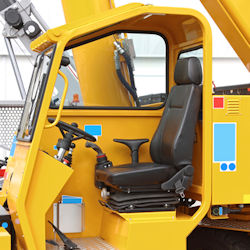Design, Construction and Testing
For equipment to be used safely, it must be built with appropriate safety features and maintained in a safe condition. Although manufacturers are not directly subject to this standard, crane users rely on manufacturers to see that the equipment is built and tested so that it is safe when it leaves the manufacturer.
The crane user, which is typically the employer, has an obligation to verify the equipment has been designed, constructed, and tested to meet the job requirements. This can typically be done by referring to the manufacturer's documentation. It's also important for the employer to verify the crane has not been modified since it was manufactured.
You cannot rely on manufacturer documentation to comply with the requirements below:
Rated Capacity and Related Information Requirements
The following information must be available in the cab:
- a complete range of the manufacturer's equipment rated capacities
- a work area chart for which capacities are listed in the load chart (the work area figure and load chart must clearly indicate the areas where no load is to be handled)
- recommended reeving for the hoist lines
- recommended parts of hoist reeving, size, and type of wire rope for various equipment loads
- recommended boom hoist reeving diagram, where applicable
- size, type and length of wire rope
- tire pressure (where applicable)
- caution or warnings relative to limitations on equipment and operating procedures, including an indication of the least stable direction
- position of the gantry and requirements for intermediate boom suspension (where applicable)
- instructions for boom erection and conditions under which the boom, or boom and jib combinations, may be raised or lowered
- whether the hoist holding mechanism is automatically or manually controlled, whether free fall is available, or any combination of these
- the maximum telescopic travel length of each boom telescopic section
- whether sections are telescoped manually or with power
- the sequence and procedure for extending and retracting the telescopic boom section
- maximum loads permitted during the boom extending operation, and any limiting conditions or cautions
- hydraulic relief valve settings specified by the manufacturer
Knowledge Check Choose the best answer for the question.
6-2. It's also important for the employer to verify the crane _____.
You forgot to answer the question!

